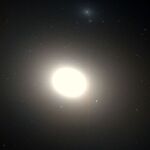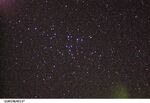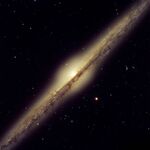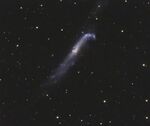| Constellations (8) | |
|---|---|
| Boötes, Canes Venatici, Coma Berenices, Corona Borealis, Corvus, Libra, Serpens, Virgo | |
| Nomenclature | |
| Abbreviation | Noc |
| Genitive | Noctae |
| Pronunciation | Name: /'nok•tö•wä/ Genitive: /'nok•tā/ |
| Symbolism | the owl |
| Geometry | |
| Midpoint right ascension | 14h 01.25m |
| Midpoint declination | +12° 31.19' |
| Northernmost border | +55° 02.69' |
| Southernmost border | −29° 59.69' |
| Westernmost border | 11h 37.37m |
| Easternmost border | 18h 58.31m |
| Quadrant | NQ3 |
| Crossed by | Ecliptic Equator Autumn meridian Winter meridian |
| Bordering caelregios | Owl part: Avis (N) Felis (W) Simianus (SE) Tarandus (E) Feather part: Tarandus (all sides) |
| Segments | 42 |
| Area | 4590.419 sq. deg. (2nd) |
| Proportion of the sky | 111.275‰ |
| Average constellation area | 573.802 sq. deg. (5th) |
| Stars | |
| Named stars | 37 |
| Stars in the figure | 8 |
| Naked eye stars (m < 6.50) |
347 |
| BF stars | 387 |
| Bright stars (m < 3.00) |
13 |
| Brightest star | Arcturus (−0.04m) |
| Nearby stars (D < 10.00 pc, 32.62 ly) |
24 |
| Nearest star | Ross 128 (3.35 pc, 10.94 ly) |
| Messier objects | 26 |
| Visibility | |
| Full visibility range | 60°N–34°S |
| Partial visibility range | 90°N–60°N 34°S–90°S |
| Midnight culmination date | April 20 |
| Zodiac | |
| Astrological sign | 8/22–10/23 |
| Solar sign | 9/16–11/22 |
Noctua is a two-part caelregio located in the third quadrant of the northern hemisphere at its midpoint, but it extends into the southern hemisphere, fourth quadrant, and into the second quadrant. Noctua is the second largest caelregio after Hippocampus with an area of 4590 square degrees, covering about 111‰ of the celestial sphere. Noctua is divided into eight constellations (listed in the infobox), including Virgo, which is the second largest constellation after Hydra in Felis.
Noctua is the only caelregio with two separated parts with smaller part being Serpens Cauda, which is one of the two parts of the constellation Serpens. The two parts of Noctua are separated by Tarandus while the two parts of Serpens are separated by Ophiuchus the serpent-holder.
Noctua contains the Virgo Cluster of Galaxies as well as many other notable deep sky objects. This caelregio contains the only interesting binary or multiple star system, but there are five interesting planetary systems.
Name and symbolism[]
Noctua is directly named after the former constellation where it was located between the end of the Hydra's tail and Libra.
Noctua is originally named after the Latin word for (little) owl. It can be imagined that Noctua influence two component constellations. Owls eat snakes (Serpens), and are domesticated by herders (Boötes). It is also imagined that hunting dogs (Canes Venatici) chase owls, but owls can easily get away since owls can fly while dogs cannot.
Notable stars[]
Bright stars[]
A K-type giant Arcturus is the Noctua's brightest star at a magnitude of −0.04, located in Boötes. It is also the third brightest overall after Sirius in Araneus and Canopus in Malus. Arcturus, along with Spica, Cor Caroli, and Denebola, make up the Diamond of Virgo with three stars (excluding Cor Caroli) making up the Spring Triangle.
The other notable bright stars in Noctua are
- Spica –– a 0.98m B-type giant located in Virgo. Spica is one of the four brightest stars within 5° of the ecliptic, the others are Antares in Simianus, Regulus in Felis, and Aldebaran in Araneus;
- Gemma –– a 2.21m A-type main sequence located in Corona Borealis;
- Zubeneshamali –– a 2.61m B-type main sequence located in Libra;
- Unukalhai –– a 2.63m K-type giant located in Serpens; and
- Cor Caroli –– a 2.90m A-type main sequence located in Canes Venatici.
Nearby stars[]
A red dwarf Ross 128 is the Noctua's nearest star at a distance of 10.94 light-years (3.35 parsecs), located in Libra.
Variable stars[]
Alpha2 Canum Venaticorum is a prototype variable star. Its brightness fluctuates from 2.84 to 2.98 with a period of 5.47 days.
44 Boötis is an eclipsing binary of W Ursae Majoris type plus a spectroscopic binary. The magnitude varies from 5.80 to 6.40 with a 6.43-hour period. The components of the eclipsing binary are separated by just 0.008 AU, which is three times the Earth–Moon separation.
Multiple stars[]
One notable multiple star system is Gliese 570 in Ophiuchus, which comprises of a K-type star, a binary pair of M-type stars, and a T-dwarf.
Planetary systems[]

The PSR B1257+12 system, notice that the foreground planet has a swirling aurora caused by intense radiation from parent pulsar around which the magnetic field lines are visible
As of 2015, there are nearly a hundred exoplanets orbiting around approximately 75 stars in Noctua. A notable example is PSR B1257+12 (P1 Noc) in Virgo, which has three terrestrial planets. The two most massive planets are the first confirmed exoplanets discovered on January 22, 1992.
Another example is Gliese 581 (P10 Noc) in Libra which has four confirmed planets, including three super-Earths. Themis (Gliese 581 d, P220) orbits in the outer region of the habitable zone, while Eirene (Gliese 581 c, P209) orbits in the inner region. Themis is speculated to be an ocean planet with an equilibrium temperature of 203 K while Eirene is speculated to be a desert planet with a temperature 350 K.
Also in Virgo, 61 Virginis (P29 Noc) has three planets: one super-Earth and two midplanets; and likely more. 61 Virginis is speculated to have nine planets.
Another planetary system of interest is COROT-9 (P30 Noc) in Serpens. COROT-9 has a temperate transiting exoplanet that lies in the Mercury-like distance from the star. The planet Typhoeus (COROT-9b, P404) has a period of 95 days, slightly longer than an 88-day period for Mercury. The mass of this planet is 5⁄6 the mass of Jupiter but slightly larger in size, yielding a mean density slightly lower than water.
In Serpens, there is the pulsar PSR J1719-1438 (P53 Noc), which contains a diamond planet Tapio (PSR J1719-1438 b, P576) that was formerly a white dwarf before it lost more than 99.9% of its original mass to parent pulsar via mass transfer because it orbits so close to its pulsar at a distance of 0.666 gigameter (0.957 solar radii) that it takes only 2.177 hours to orbit the star, which is the shortest orbital period of any known planet. Tapio has a density of 23 g/cm3, which is the densest planet ever measured, about the same as two densest known elements (osmium and iridium).
Notable deep sky objects[]
Noctua contains the famous Virgo Cluster containing many individual galaxies. The examples of galaxies outside the Virgo Cluster are the Whirlpool Galaxy (M51a, NGC 5194), Whale Galaxy (NGC 4631), M106 (NGC 4258), Sunflower Galaxy (M63, NGC 5055), and M94 (NGC 4736), which are all spiral galaxies located in Canes Venatici. The Whirlpool Galaxy is a grand design spiral galaxy interacting with its smaller companion, NGC 5195 (M51b). Virgo Cluster contains Markarian's Chain, an arrangement of galaxies.
In Virgo, the Sombrero Galaxy (M104, NGC 4594), which is an unbarred spiral galaxy nearly edge-on, can be seen famous. The most famous elliptical galaxy M87 (also called Virgo A) (NGC 4486) can also be seen famous in Virgo. Also in Virgo, the lenticular galaxy M86 (NGC 4406) can be seen. M86 is close to another lenticular galaxy M84 (NGC 4374). M60 (NGC 4649) is another elliptical galaxy in Virgo which may be interacting with a nearby spiral companion NGC 4647. All of these galaxies in this paragraph are members of the Virgo Cluster.
3C 273, which was the first quasar identified in 1963, is also located in Virgo. NGC 4151, which is a spiral Seyfert galaxy that is the strong X-ray source, is located in Canes Venatici.
In Serpens, Hoag's Object (PGC 54559) can be found, which is an unusual type of galaxy called the ring galaxy. Also in Serpens, there is IC 1101, which is the largest [lenticular] galaxy known at 5.5 million light-years across located 1.07 billion light-years from the Milky Way at the center of the Abell 2029 galaxy cluster. Again in Serpens, there is Seyfert's Sextet (UGC 10116), a group of six galaxies with NGC 6027 being the brightest member. However because of the gravitational pull of all six members, all six will eventually merge to form one giant elliptical galaxy within the next several hundred million years.
In Serpens, there is the Eagle Nebula (M16, NGC 6611), which contains a prominent feature called "Pillars of Creation." There is another nebula in Serpens: the Red Square Nebula (MWC 922), which is a bipolar nebula recently discovered in April 2007.
In Corvus, the Antennae Galaxies (NGC 4038 and NGC 4039, C60 and 61) can be found, in which a pair of galaxies are merging together to form one supergalaxy. In Coma Berenices, the Mice Galaxies (NGC 4676) is a merging pair of spiral galaxies in the Coma Cluster. Also in this constellation, there are the spiral galaxies M100 and the Black Eye Galaxy (also known as the Sleeping Beauty Galaxy or the Evil Eye Galaxy) (M64, NGC 4826). Coma Berenices also contains the irregular galaxy NGC 4449 (C21) similar to the Large Magellanic Cloud.
This caelregio also contains the Coma Star Cluster (Mel 111), which is an open cluster containing about 40 stars in Coma Berenices. This cluster lies 288 light-years distant, twice as far as the Hyades in Araneus. It covers an area of 5° in the sky.
In Canes Venatici, there is the dwarf barred irregular galaxy NGC 4214 with recent and ongoing active star formations. The motto of this galaxy is "a star-formation labratory" according to an article on astronomy.com. This galaxy is located 10 million light-years away. This constellation also contains the Needle Galaxy (NGC 4565, C38), which is an edge-on spiral galaxy, and NGC 4395, which is a special type of spiral galaxy called the Magellanic spiral galaxy. This galaxy has the smallest supermassive black hole ever measured, its mass is only about 60,000 ± 5,000 solar masses, thus making the core of this galaxy appears absent.
In Boötes, there is the colliding galaxy appearing as a "cosmic exclamation point": VV 340 (Arp 302, UGC 9618). Both galaxies are spirals and they are in early stages of collision. A vertical line of an exclamation point is VV 340 North while a dot is VV 340 South. In Canes Venatici, there is the Hockey Stick Galaxies (also known as the Crowbar Galaxy) (NGC 4656-7), which is a peculiar barred spiral galaxy. The line of gas and dust looking like a length of a hockey stick is designated NGC 4656 while the bright knot of nucleus is designated NGC 4657. The distorted gas and dust looking like a blade of a hockey stick is caused by the interaction with its large neighbor, NGC 4631.
In Virgo, there is the Siamese Twins (also known as the Butterfly Galaxies) (NGC 4567 and NGC 4568), a set of spiral galaxies located in the Virgo Cluster. These two galaxies maybe in the process of colliding and merging. Also in Virgo, there is the interacting galaxy in the Virgo Cluster: the Eyes Galaxies (NGC 4435–NGC 4438, Arp 120).
Gallery[]
 The Whirlpool Galaxy (M51a, NGC 5194) interacting with NGC 5195 (M51b) |
 Hoag's Object (PGC 54559) |
 "Pillars of Creation" in the Eagle Nebula (M16, NGC 6611) |
 The Antennae Galaxies (NGC 4038 (C60, left) and NGC 4039 (C61, right)) |
 The lenticular galaxy M86 (NGC 4406) |
 The Coma Star Cluster (Mel 111) |
 The Sombrero Galaxy (M104, NGC 4594) in infrared |
 The elliptical galaxy M87 (also known as Virgo A) (NGC 4486) |
 The Sunflower Galaxy (M63, NGC 5055) in ultraviolet |
 The Black Eye Galaxy (also known as the Sleeping Beauty Galaxy or the Evil Eye Galaxy) (M64, NGC 4826) |
 The Red Square Nebula (MWC 922) |
 The irregular galaxy NGC 4449 (C21) |
 The Needle Galaxy (NGC 4565, C38) |
 Seyfert's Sextet (UGC 10116) |
 The Magellanic spiral galaxy NGC 4395 |
 The colliding galaxy VV 340 (Arp 302, UGC 9618) |
 The Siamese Twins (also known as the Butterfly Galaxies) (NGC 4567 and NGC 4568) |
 |
 The Hockey Stick Galaxies (also known as the Crowbar Galaxy) (NGC 4656-7) |
Notable meteor showers[]
Every year on January 3–4, the Quadrantids (also called Noctids) peak, caused by the minor planet 2003 EH1. During this meteor shower, up to 40 meteors per hour would be visible. This meteor shower is named after the former constellation Quadrans Muralis where it is now part of Boötes.
Visibility[]
In the northern hemisphere, Noctua can be visible during the first two months of fall. Since Noctua is an equatorial caelregio, it can be seen from around the world, but all of it can only be visible from 60°N down to 35°S. The whole caelregio can be seen from most of Americas including the United States, Africa, most of Eurasia, and most of Oceania.
The most prominent constellation in Noctua is Boötes, which contains three bright stars (m<3.00) including a star below zero magnitude. Seven out of eight constellations in this caelregio contain at least one star brighter than 3.00m.
Zodiac[]
The Sun appears to cross Noctua from September 16 till November 22: it crosses the constellations Virgo (September 16 till October 30) and then Libra (October 31 till November 22). This zodiacal caelregio is located between Felis to the west and Simianus to the east.
Noctua was formerly in the sign of zodiac from August 22 till October 23.
| |||||